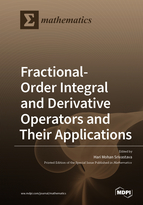Fractional-Order Integral and Derivative Operators and Their Applications
A special issue of Mathematics (ISSN 2227-7390). This special issue belongs to the section "Difference and Differential Equations".
Deadline for manuscript submissions: closed (30 November 2019) | Viewed by 80905
Special Issue Editor
Interests: real and complex analysis; fractional calculus and its applications; integral equations and transforms; higher transcendental functions and their applications; q-series and q-polynomials; analytic number theory; analytic and geometric Inequalities; probability and statistics; inventory modeling and optimization
Special Issues, Collections and Topics in MDPI journals
Special Issue Information
Dear Colleagues,
In recent years, various families of fractional-order integral and derivative operators, such as those named after Riemann-Liouville, Weyl, Hadamard, Grunwald-Letnikov, Riesz, Erdelyi-Kober, Liouville-Caputo, and so on, have been found to be remarkably important and fruitful, due mainly to their demonstrated applications in numerous seemingly diverse and widespread areas of the mathematical, physical, chemical, engineering, and statistical sciences. Many of these fractional-order operators provide interesting, potentially useful tools for solving ordinary and partial differential equations, as well as integral, differintegral, and integro-differential equations; fractional-calculus analogues and extensions of each of these equations; and various other problems involving special functions of Mathematical Physics and Applied Mathematics, as well as their extensions and generalizations in one or more variables.
In this Special Issue, we invite and welcome review, expository, and original research articles dealing with the recent advances in the theory of fractional-order integral and derivative operators and their multidisciplinary applications.
Prof. Dr Hari Mohan Srivastava
Guest Editor
Manuscript Submission Information
Manuscripts should be submitted online at www.mdpi.com by registering and logging in to this website. Once you are registered, click here to go to the submission form. Manuscripts can be submitted until the deadline. All submissions that pass pre-check are peer-reviewed. Accepted papers will be published continuously in the journal (as soon as accepted) and will be listed together on the special issue website. Research articles, review articles as well as short communications are invited. For planned papers, a title and short abstract (about 100 words) can be sent to the Editorial Office for announcement on this website.
Submitted manuscripts should not have been published previously, nor be under consideration for publication elsewhere (except conference proceedings papers). All manuscripts are thoroughly refereed through a single-blind peer-review process. A guide for authors and other relevant information for submission of manuscripts is available on the Instructions for Authors page. Mathematics is an international peer-reviewed open access semimonthly journal published by MDPI.
Please visit the Instructions for Authors page before submitting a manuscript. The Article Processing Charge (APC) for publication in this open access journal is 2600 CHF (Swiss Francs). Submitted papers should be well formatted and use good English. Authors may use MDPI's English editing service prior to publication or during author revisions.
Keywords
- Operators of fractional calculus and their applications
- Chaos and fractional dynamics
- Fractional-order ODEs and PDEs
- Fractional-order differintegral equations
- Fractional-order integro-differential equations
- Fractional-order integrals and fractional-order derivatives associated with special functions of mathematical physics and applied mathematics
- Identities and inequalities involving fractional-order integrals and fractional-order derivatives
- Dynamical systems based upon fractional calculus
Benefits of Publishing in a Special Issue
- Ease of navigation: Grouping papers by topic helps scholars navigate broad scope journals more efficiently.
- Greater discoverability: Special Issues support the reach and impact of scientific research. Articles in Special Issues are more discoverable and cited more frequently.
- Expansion of research network: Special Issues facilitate connections among authors, fostering scientific collaborations.
- External promotion: Articles in Special Issues are often promoted through the journal's social media, increasing their visibility.
- e-Book format: Special Issues with more than 10 articles can be published as dedicated e-books, ensuring wide and rapid dissemination.
Further information on MDPI's Special Issue polices can be found here.






